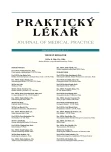How is perceived the nutritional food composition by our senses
Authors:
J. Brát 1; O. Herber 2; M. Sahánek 3
Authors‘ workplace:
Vím, co jím a piju o. p. s.
Předseda správní rady: Robert Svoboda
1; ÚVL 1. LF UK v Praze
Přednosta: doc. MUDr. Bohumil Seifert, PhD.
2; KNORR Kuchařské studio, Unilever Foodsolutions
Ředitel: Milan Sahánek
3
Published in:
Prakt. Lék. 2011; 91(3): 138-143
Category:
Of different specialties
Overview
The issue of food, nutrition and cooking focuses considerable attention in the media. The nutritional value, however, is usually not a major issue. The spread of various myths does not contribute to the right education of the consumers. We can also find the attitude: “What is healthy is not tasteful.” Studies comparing the nutritional and sensory properties of foods in the scientific literature are not common. Within the five-weekend training seminars for general practitioners, we gave a total of fifteen dinner meals (five appetizers, five main dishes and five desserts). The various dishes were prepared using vegetable fats, alternating with animal fats. Using questionnaires, we evaluated the taste of these dishes. Then we compared the sensory properties in relation to nutritional values. It was found that differences in taste were not significant, while the replacement of animal fat plant can meaningly improve the nutritional value of food. Selecting suitable fat may approach the nutritional recommendations without meaningful alteration of the taste of food.
Key words:
sensory and nutritional properties of food, nutrition recommendations, saturated fatty acids, fatty acids, salts, sugars.
Sources
1. Diekman, C., Malcolm, K. Consumer perception and insights on fats and fatty acids: knowledge on quality of diet fat. Ann. Nutr. Metab. 2009, 54 (suppl. 1), p. 25-32.
2. Schickenberg, B., van Assema, P., Brug, J. et al. Replacing foods high in saturated by low-saturated fat alternatives: a computer simulation of the potential effects on reduction of saturated fat consumption. Br. J. Nutr. 2009, 102, p. 478-483.
3. Siri-Tarino, P.W., Sun, Q., Hu, F.B., Kraus, RM. Meta-analysis of prospective cohort studies evaluating the association of saturated fat with cardiovascular disease. Am. J Clin. Nutr. 2010, 91(3), p. 535-546.
4. Mozaffarian, D., Micha, R., Wallace, S. Effects on Coronary Heart Disease of Increasing Polyunsaturated Fat in Place of Saturated Fat: A systematic Review and Meta-Analysis of Randomized Controlled Trials. PLoS Medicine 2010, 3, 3, p. 1-10.
5. Brát, J., Dostálová, J., Herber, O. Tuky - metaanalýzy, nové doporučené dávky, novinky v legislativě 2009/2010. Prak. Lék., 2011, 91, 2, s. 91–95.
6. Confederation of the Food and Drink Industries of the EU (CIAA) 2009: CIAA values and rationale for the additional set of GDAs [on-line]. Dostupný z www: http://gda.ciaa.eu/asp2/gdas_portions_rationale.asp?doc_id=129.
Labels
General practitioner for children and adolescents General practitioner for adultsArticle was published in
General Practitioner

2011 Issue 3
- Metamizole vs. Tramadol in Postoperative Analgesia
- Metamizole at a Glance and in Practice – Effective Non-Opioid Analgesic for All Ages
- Memantine Eases Daily Life for Patients and Caregivers
- Memantine in Dementia Therapy – Current Findings and Possible Future Applications
- Hope Awakens with Early Diagnosis of Parkinson's Disease Based on Skin Odor
Most read in this issue
- Nontuberculous mycobacteria
- A case report of a male with distinctive cervical lymphadenopathy of unknown aetiology
- Current trends in care for facial cleft affected child
- Smoking and nutrition
